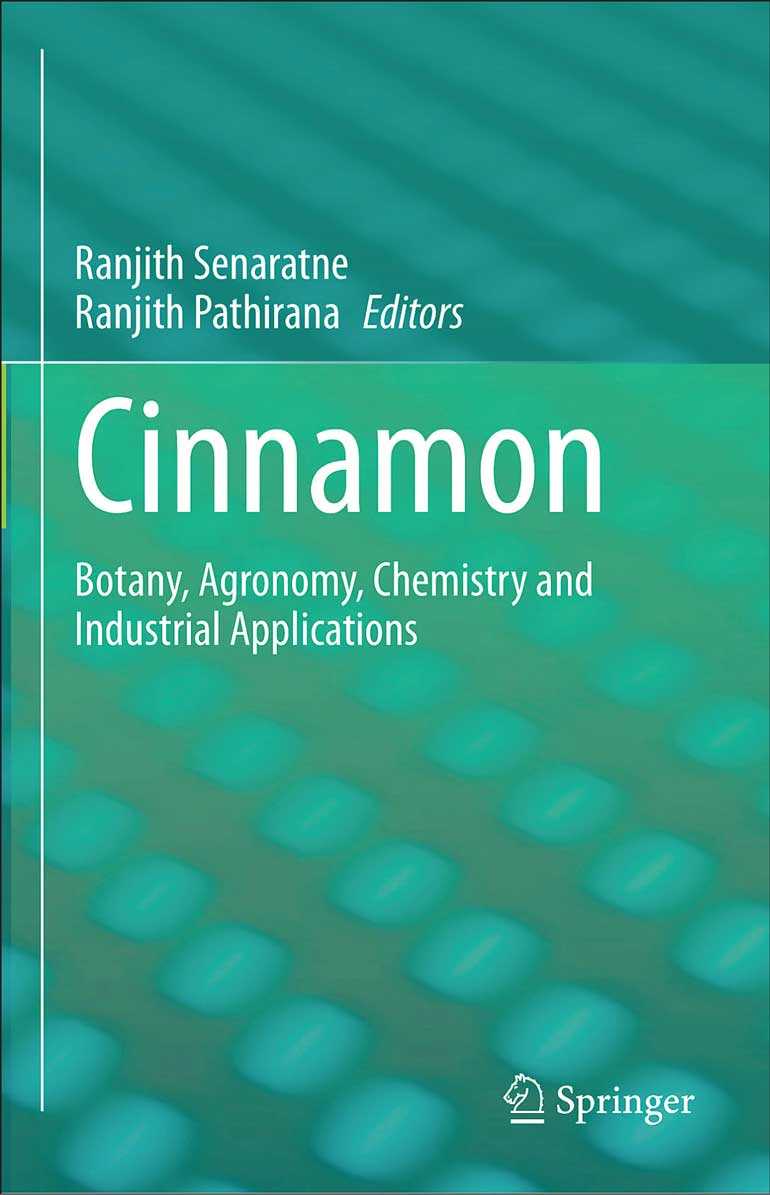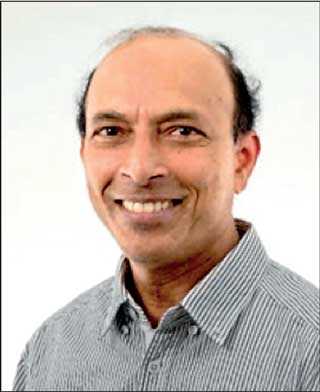Tuesday Dec 23, 2025
Tuesday Dec 23, 2025
Monday, 8 March 2021 00:30 - - {{hitsCtrl.values.hits}}
 Attempt at rediscovering Zeylan
Attempt at rediscovering Zeylan
Two Ranjiths, Ranjith Senaratne – formerly Professor of Crop Sciences at Ruhuna University and presently Chairman, National Science Foundation – and Ranjith Pathirana – also formerly Professor at Ruhuna and presently at Plant and Food Research Australia – have done the impossible but a necessity today. The duos have mobilised 42 scientists and researchers from all over the world and released their collected works on cinnamon industry in the form of an edited publication.
The volume titled ‘Cinnamon: Botany, Agronomy, Chemistry and Industrial Applications’ has been published by Springer in May 2020. As the subtitle denotes, it is a store of knowledge for all those involved in the cinnamon industry from growers to final consumers.
It is specifically important for Sri Lankans because it deals with the one and only cinnamon variety home to Sri Lanka, called Cinnamomum Zeylanicum. This plant, known as true cinnamon, is Sri Lanka’s home product. The other cinnamon traded in the market, namely Cassia, is therefore a fake cinnamon. The work of Senaratne and Pathirana is, hence, a rediscovery of Zeylan as the country was called in ancient times when it was known for the best cinnamon in the world, while offering a window for its future with a vast array of new openings in its drive toward prosperity. Thus, cinnamon, if handled properly, is one product that could make or break Sri Lanka in the future.
Cinnamon, the brown gold
Cinnamon was ‘brown gold’ in ancient times like ‘black gold’ today. Those who managed its trade or owned its source were to become rich very quickly. Consequently, countries in the tropics were invaded, colonised, or occupied by Western powers mainly because of the availability of quality cinnamon in those lands. In this connection, ancient Lanka had a unique position because of the superior quality cinnamon it produced by harvesting the naturally grown cinnamon plants in its rainforest jungles.
 |
| Cinnamon Cover page |
 |
| Prof. Ranjith Senaratne |
 |
| Dr. Ranjith Pathirana |
For thousands of years, cinnamon trade between ancient Lanka and Western Europe was in the hands of the Arab traders. But soon this got shifted to the Portuguese followed by the Dutch when they began to occupy the maritime provinces of the country from around early 16th century. Initially, it was cinnamon that grew naturally in the jungles that was harvested.
The Dutch giving birth to commercial cultivation of cinnamon
But when that was insufficient to meet the rising demand for the produce in Europe, the Dutch experimented with growing cinnamon as a commercial product. This was the birth of cinnamon cultivation as a commercial crop in the country. During the Dutch times, according to Nirmal Dewasiri and others who have written Chapter 2 of the volume, Lanka supplied about 5,000 bales which was roughly equal to about 300 metric tons of cinnamon annually. With its cultivation as a commercial crop that expanded dramatically from around 1960s, it now produces on average about 24,000 metric tons annually. A favourable feature in this development has been the continuous increase in the yield rate of cinnamon from 4,727 metric tons per hectare in 1961 to 7258 metric tons in 2018. As a result, when the area under cultivation has increased by three times, the total cinnamon production has increased by nearly five times.
Too short of a supply needing quick improvement
The main argument presented by Senaratne and Pathirana is that this is a too short of a supply and, hence, by aligning all systems – cultivation, production, value addition, and marketing – to cinnamon, this can be significantly increased. The 17 papers in the volume covers, from experts’ point of view, all these aspects relating to the development of cinnamon industry in Sri Lanka.
A special downside risk in this case is that there are eight identified varieties of cinnamon home to Sri Lanka but all of them are either endangered or vulnerable to be endangered in the wilds of the country. The conservation of these varieties should be a matter of urgency since the forest cover of the country is fast depleting, say Senaratne and Pathirana.
Zeylan entering into trade agreements to supply cinnamon
The introductory chapter by Senaratne and Pathirana has taken the reader through a historical perspective of the country’s cinnamon industry, highlighting its unique feature of being the true cinnamon as against the fake cinnamon widely available in the global markets.
Similar to the bilateral trade agreements which Sri Lanka has with other trading partners today, say Senaratne and Pathirana, Lankan kings in the 13th century CE had entered into a trade agreement with the Sultan of Egypt to supply him with numerous locally produced merchandise including cinnamon. This would have had an adverse effect too. The word would have spread that Zeylan was a source of super quality cinnamon inducing greedy Western powers to search for that source and have a beneficial ownership interest in that land.
Open new land for cinnamon by intercropping and multi-cropping in coconut and rubber lands
Cinnamon production has upside prospects for Sri Lanka to create wealth for its people. However, the limitation of the available cultivable land is one of the pressing obstacles for the country to expand the area under cultivation. Drawing on various research studies, Senaratne and Pathirana have suggested that intercropping – or even multi-cropping with other crops – of cinnamon in the existing coconut and rubber lands should be a way out to resolve this issue.
Both coconut and rubber would symbiotically benefit from such a marriage in the form of a yield enhancement by allowing cinnamon leaves to be composted once stems are harvested. They have concluded that about 140,000 ha of new land could be made available for cultivating cinnamon in the country by using this method. This is a significant addition – a rough estimate is about 1 million metric tons – to the total cinnamon production given the current yield rate of about 7000 metric tons per hectare.
 Go for value addition to prevent price dips
Go for value addition to prevent price dips
However, this should be carefully planned since oversupplying raw cinnamon in quill form to the world market may dip the prices thereby negating the advantage of an increased production. The solution lies in making cinnamon a valued added product by using it as a raw material for industrial applications. The range of products that can be produced is very wide from medicines to therapeutics to nutraceuticals to green perfumes and to air fresheners, some known products for which cinnamon could be used as an ingredient. Chapter 11 by Hanouf Ismail and others have discussed the potential of cinnamon as a therapeutic agent in neurological disorders and metabolic syndrome.
They have concluded that cinnamon has been effectively used in slowing down the progression of neurological disorders and cancer and therefore, it is an avenue to be explored further to get the full application of cinnamon for therapeutic purposes. In Chapter 12, G.A.S. Premakumara and W.P.K.M. Abeysekera have presented a detailed account of pharmaceutical properties of Ceylon cinnamon. According to them, cinnamon contain medicinal properties to address several modern-day common illnesses. They include cancer, diabetes, arthritis, inflammation, high cholesterol, immunity deficiency, painkilling, and heart protecting. Their conclusion is that cinnamon can be used as a medicine for these diseases without significant side effects.
Cinnamon for industrial use
Chapter 13 by Tuley de Silva has further elaborated on the industrial application of Ceylon cinnamon. Cinnamon has been used for millennia for Ayurvedic medicines. About the Ayurvedic use of cinnamon, De Silva says: “Cinnamon has been used in Ayurveda to treat nausea, digestive disorders, painful menstrual problems, anaemia and respiratory conditions. It has also been used to improve blood circulation, control blood sugar levels, and relieve headaches, flu and colds, particularly for people classed under the kapha Ayurvedic type. Its essential oil has been used in soothing nerves and muscle pains. The bark powder has been used in tooth powders, and the oil has been used for medicinal purposes, such as toothaches and dental problems.” In addition, the other industrial uses of cinnamon include aromatherapy, dietary and nutritional supplements, and prevention of obesity.
De Silva concludes his paper as follows: “New products have to be launched into the market after considering pre-market resources and consumer affordability, making sure to guarantee product safety and quality in the marketplace. As described before, cinnamon is reported to possess many health-promoting and healing properties. Extensive research has to be conducted to develop nutraceutical and cosmeceutical products for these effects for the benefit of consumers. With so many benefits, the popularity of cinnamon herbal supplements and cosmetics will continue to flourish. Taking cinnamon as a daily supplement, in the right dose, will provide a significant impact on human health that will help a person look, feel better and live longer”.
Research to be followed by commercial production
This is sound economics which has established that research alone will not help a country to attain prosperity for its people. Research should be followed by development, marketing, and entrepreneurship. This was presented by Austrian-American economist Joseph Schumpeter in 1942. He said invention – creation of new products – should be followed by three other essential requirements. Inventions should lead to commercial production, a process which he called innovation. Then, knowledge about it is spread – diffusion – and all others will imitate it making it a common product.
Public Private Partnership in cinnamon
In Chapter 14, Kumudini Gunasekare and others have presented a blueprint of how public private partnership could be used for the growth and development of the cinnamon industry in Sri Lanka. According to them, while the private initiatives handle the major part of the industry, the public sector entities should provide a facilitating role. This includes training and capacity building of cinnamon value chain actors, preparation of a roadmap for its protection, enhancing regulatory compliance, promoting competition among the actors, and helping the country to establish a ‘pure Ceylon cinnamon brand’, like the Ceylon tea brand.
This should lead to value creation in cinnamon, as analysed by Renda K.C. Jeewanthi and others in Chapter 15. At present, the export basket of cinnamon from Sri Lanka is made up of cinnamon in raw form; the authors have argued that many other products can be developed like cinnamon alcohol and cinnamon chewing gum.
Improving value chain
The development of the value chain dynamics of cinnamon has been the focus of chapter 16 by Achini M. De Silva and Mohamed Esham. In the cinnamon value chain in Sri Lanka, there are growers, processors, financiers, governmental institutions, buyers and exporters. But with cinnamon as an industrial raw material, the chain has to be strengthened by adding industrialists as well. According to the authors, the present value chain in cinnamon is scattered and fragmented needing improvement.
They have therefore concluded that “Value chain-wide intervention on R&D, market research, mechanisation and adaptation to appropriate technology, introduction of modern human resources management into cinnamon value chain, crop improvement and high-end value addition are prime needs of Ceylon cinnamon industry. Moreover, value chain integration and establish string links with institutional partners are essential for value chain upgrading”.
Hence, there is the necessity for building a globally competitive cinnamon industry. Buddhi Marambe and others have discussed this in Chapter 17. Quality assurance is a must in this enterprise, according to the authors.
New cultivars to get the names of ancient kings: Sri Wijaya and Sri Gemunu
As the present volume has argued, the development of cinnamon industry requires yield improvement and a short juvenile period to offer an economical income to growers. For that, new crops have to be developed. Chapters 4, 5, and 6 have dealt with this issue in detail. In this connection, an important achievement has been the cloning and introduction of two new plants of cinnamon named after two Sinhala kings, ‘Sri Wijaya’ and ‘Sri Gemunu’, by Sri Lanka’s National Cinnamon Research and Training Centre, a public entity functioning under the Department of Export Agriculture. The research on cloning of new varieties of cinnamon should be continued as the long-term strategy for developing the cinnamon sector.
Ceylon cinnamon is less anti-liver than cassia
Cinnamon contains a toxic called coumarin that cause liver damage. However, in Ceylon cinnamon this toxic is found only in traces. But, in cassia, the fake cinnamon, contains a large quantity of coumarin. When this is known to the consumers, naturally, there will be a high demand for Ceylon cinnamon. Right now, the country is not able to increase production to meet the new demand. This will lead to price increases prompting other countries like China and Vietnam to enter the market with their own cinnamons. This is unavoidable in the present age of genetic research and modification techniques.
Therefore, it is necessary to augment the value addition in cinnamon to thwart the unwieldy competition that may come from late entrants to the industry. This is an important factor which Sri Lanka’s policymakers should keep in their mind when preparing the strategic roadmap for the development of the country’s cinnamon industry.
The volume published by Senaratne and Pathirana provides good source materials for solving this problem.
(The author, a former Deputy Governor of the Central Bank of Sri Lanka, can be reached at [email protected].)